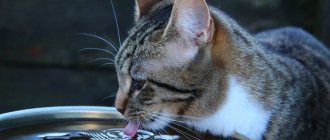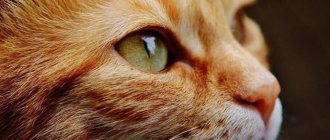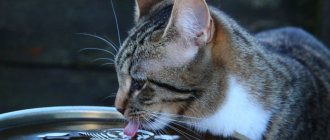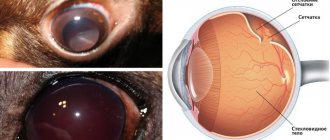Causes and symptoms of eye diseases in cats
Symptoms can be very different. An appropriate treatment must be selected for a specific disease.
Inflammation in the eyes of a cat
Entropion (etropion)
The first reason is etropion. Also called entropion. The edge of the lower eyelid bends inward, and the animal feels severe pain.
Important! If the volvulus is not treated in time, keratoconjunctivitis will develop.
Iritis (iridocyclitis)
Photophobia, yellow iris, constricted pupil are symptoms of inflammation of the iris. This disease is called iritis. Occurs due to bacterial infection, injury and metabolic disorders.
Third eyelid prolapse
The third eyelid performs a protective function. If this protective device for the cat's eyes falls out of its boundaries, then foreign bodies, viruses or bacterial infections have entered the eye. Poisoning of the body and allergic reactions occur, and nervous disorders are possible.
Cataract
When the optical areas of the lens are affected, the cat begins to show symptoms:
- lethargy;
- poor orientation;
- blindness;
- pupil dilation
Because of this, the cat becomes fearful and sometimes aggressive. The eye may become completely opaque and a cataract will appear.
Cataract on the vitreous body
Conjunctivitis
As a result of conjunctivitis, redness and swelling of the eyelid develop, and the eye begins to water. The eyelids may turn out and movement of the eyeballs may be impaired. The disease occurs due to bacteriological effects on the conjunctiva that protects the eye.
Inflammation of the third eyelid
The symptoms and causes of inflammation of the third eyelid are similar to those of prolapse. The eye begins to fester, and the kitten experiences severe discomfort.
Wounds of the eyelids
Pets may experience eyelid damage. This occurs due to mechanical damage from teeth, claws and other foreign objects that can rip off the eyelids. Inflammatory swelling and constant slight bleeding develop.
Blepharitis
Blepharitis is inflammation of the eyelids. It should not be confused with ordinary conjunctivitis. The disease most often occurs due to burns (including chemical ones), allergic reactions and mechanical damage to the cornea.
Against the background of blepharitis occurs:
- baldness around the eyes;
- the incision begins to rapidly decrease;
- redness appears;
- severe inflammation of the eyelid.
As a result, the pet's viewing angle is severely limited and disorientation appears.
Blepharitis in a cat
Adenoma of the third century
A small tumor, the size of a pea, appears in the cat's eye. Often white or bright pink in color. Benign origin does not guarantee safety, since the tumor leads to complete closure of the eye.
Dacryocystitis
The next cause of disease is inflammation of the nasolacrimal sac on the eye. A swelling appears at the site of the gland, and purulent mucous fluid often comes out of it. There is an increase in temperature and severe lacrimation.
Attention! This inflammation leads to the following problems: conjunctivitis, which provokes keratitis and a number of other diseases.
Panophthalmitis
Severe damage to the tissue of the eyeball. After staphylococci and streptococci penetrate into the eye, complete destruction of the tissues of the organ of vision from the inside develops. Within a few days, the animal’s health deteriorates sharply, and the organ begins to become severely inflamed.
Important! Appetite and sleep become poor, followed by fever and fever.
Keratitis
Inflammation of the cornea is called keratitis. The main symptom is corneal clouding of varying severity. Damage occurs due to deep eye injuries and external pathological influences
Foreign bodies entering the eye
The curiosity of cats plays a cruel joke on them. If the animal squints, blinks frequently and rubs its eye with its paw, then a foreign object is stuck in the eye. This could be dust, grass, debris, sand, etc.
Inflammation of the eyes in cats, which relates to these diseases
Such ailments include:
- conjunctivitis;
- keratitis;
- inflammation of the nasolacrimal duct;
- blepharitis;
- panophthalmitis.
What eye diseases in cats are non-inflammatory?
- bruises (or any other injuries received by a cat, for example, during a fight with other cats);
- entry of any foreign body into the eye;
- entropion of the eyelid;
- glaucoma.
As for the course of the disease itself, the following classification is noted here:
- subacute;
- spicy;
- chronic.
Therefore, carefully ensure that your animal is not exposed to such a dangerous illness, and at the first symptoms of an inflamed kitten’s eye, call a veterinarian! Otherwise, this can lead to other health problems, especially if the cause of the illness is an infection introduced into the body.
Such cases do not require delay. Eye diseases in cats are divided into:
- primary are those that are the main disease;
- secondary – those that began due to a more serious violation of the animal’s physical health (again, any infections can be included here).
In order to be able to provide proper assistance to your animal, you will need to treat the disease itself, and not its consequences in the form of clinical symptoms.
Our veterinary center and its entire qualified staff are always ready. Our specialists are very interested in ensuring that each animal can receive the care it needs and be cured in the shortest possible time.
Diagnosis of eye diseases in cats
If this misfortune has befallen your pet, you should immediately consult a veterinarian. The organ of vision is examined and its general condition is assessed according to three parameters:
- appearance of the eyeball and surrounding tissues;
- general condition: size, shape, presence of injuries;
- state of vision.
After a superficial diagnosis, a study is carried out using special devices. The fundus of the eye is examined, the sensitivity of the microflora to antibiotics is determined, and the pressure inside is measured. A specialist may prescribe a biochemical blood and urine test.
Fundus examination by a veterinarian
Possible causes of eye diseases
The cat's body is a single whole; if at least one organ or system does not function correctly, the consequences can be unpredictable. In most cases, eye pathologies are the result of some external or internal disorder.
The most common causes of such diseases:
- disturbances of metabolic processes in the animal's body;
- physical injuries - injuries, bruises, consequences of blows to the head;
- age – old cats, due to age-related changes, are more susceptible to various diseases, including ophthalmological ones;
- local disorders - these include problems affecting the organs of vision. This may be due to eye contamination due to improper care of the pet, impaired secretory function of the eyes, etc.;
- congenital diseases - some pathological processes are the result of an infectious lesion that could develop at birth;
- unfavorable living conditions - cats are ambitious creatures, but if there are many pathogenic microorganisms in their habitat, the immune system may not be able to resist their onslaught.
These are just the most common causes of eye disease in cats. To these can be added stress in the animal, nutritional disturbances, helminth damage and much more.
Eye inflammation in a cat: how to treat it at home
If the disease has not passed the irreversible stage, then treatment of eye inflammation in a cat at home is carried out conservatively. Antibacterial eye ointments and drops are used. Damaged organs of vision should be thoroughly rinsed with a weak solution of furatsilin before treatment.
The most popular substances found in ointments and drops:
- Erythromycin,
- Gentamicin,
- Tetracycline,
- Levomycetin.
Surgical intervention is resorted to in advanced cases of serious illnesses, for example, with panophthalmitis, this is the only method of treatment. The success of vision preservation depends on timely and correct diagnosis.
How to recognize the symptoms of eye inflammation in cats
Of course, in order to distinguish and understand what’s what, you need to know the symptoms of the disease. And it is as follows:
- Redness and inflammation of the eyelid.
- Redness of the eyeball.
- Protrusion of the conjunctiva itself, the so-called “fleshyness”. This is caused by swelling, as well as the size and number of blood vessels located in the conjunctiva itself. In order to somehow be able to cope with the increased load on the eye muscles, the animal begins to “cry”, that is, remove excess fluid from the eye.
- Thick yellow or greenish discharge from the eye may indicate that the disease is infectious in nature and was caused by a fungus and/or bacteria. In this case, the animal’s eyelids may stick together.
Eye wash
The washing procedure itself does not require special skills and knowledge, but you should consult a veterinarian about the product. Otherwise, the condition will only worsen, and this will lead to the progression of the disease. Often use regular saline solution, boric acid or herbal decoctions.
Washing the cat's eyes
Healthy! You can buy ready-made solutions in pharmacies.
The best drugs for treatment
For treatment to be as effective as possible, you need to choose proven means.
Iris
Gentamicin is the active substance in the composition. Kills anaerobic and protozoan bacteria. Prescribed for conjunctivitis, keratitis, blepharitis and corneal erosion. Instilled under the conjunctiva 4 times a day. Course duration – 7 days. Cost: 150 rubles.
Leopard
Chloramphenicol and nitrofural destroy bacteria, microorganisms and viruses. Prescribed to prevent the development of infections due to mechanical damage, for the treatment of acute and chronic forms of conjunctivitis. Before use, clear the eye of purulent discharge, course – 1.5 weeks. Cost: 80 rubles per bottle.
Levomycetin
Antibiotic. Eliminates any infectious agents. Has a wide range of applications:
- blepharitis;
- keratitis;
- infected injuries to the eye area;
- any types and stages of conjunctivitis.
Eye inflammation in cats: prevention and treatment
Now you already know that absolutely all cases of both conjunctivitis and other eye diseases listed above in cats should be treated immediately! In a veterinary center, in order to make a more correct and accurate diagnosis, the animal can be scraped from the conjunctiva, that is, a bacteriological culture can be performed. When a diagnosis is made, most often the animal is prescribed drops and ointments. Drops will need to be instilled according to a schedule throughout the day. Ointments will need to be applied or placed into the inflamed eye itself, two to three times a day . Typically, ointments prescribed to animals include an anti-inflammatory substance called hydrocortisone. Sometimes, the veterinarian may prescribe the use of an oral antibiotic.
Thanks to strict adherence to the treatment schedule, most of the symptoms and causes of eye inflammation in cats can be leveled out in the animal. But, do not forget that full recovery occurs in a period of one to two weeks, and even a little more, in order to definitely consolidate the result.
Always monitor the health of your animal, do not spare any time or effort on this. For we all know one simple truth: preventing a disease is always easier than treating it later. This truth applies to both people and animals. Contact our veterinary center, we will be happy to provide assistance, sometimes you cannot do without efficient, timely consultation, but self-medication of an animal can be dangerous.











